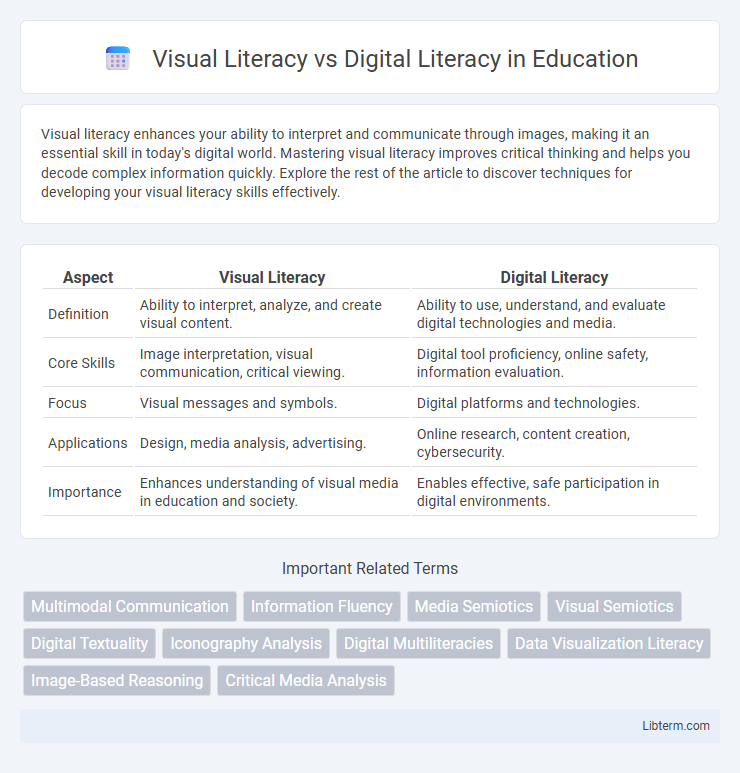Visual literacy enhances your ability to interpret and communicate through images, making it an essential skill in today's digital world. Mastering visual literacy improves critical thinking and helps you decode complex information quickly. Explore the rest of the article to discover techniques for developing your visual literacy skills effectively.
Table of Comparison
| Aspect | Visual Literacy | Digital Literacy |
|---|---|---|
| Definition | Ability to interpret, analyze, and create visual content. | Ability to use, understand, and evaluate digital technologies and media. |
| Core Skills | Image interpretation, visual communication, critical viewing. | Digital tool proficiency, online safety, information evaluation. |
| Focus | Visual messages and symbols. | Digital platforms and technologies. |
| Applications | Design, media analysis, advertising. | Online research, content creation, cybersecurity. |
| Importance | Enhances understanding of visual media in education and society. | Enables effective, safe participation in digital environments. |
Introduction to Visual Literacy and Digital Literacy
Visual literacy involves the ability to interpret, negotiate, and make meaning from information presented in the form of images, emphasizing skills like observation, analysis, and critical thinking. Digital literacy encompasses the competence to effectively use digital tools and platforms to access, interpret, create, and communicate information, highlighting technical knowledge and digital communication skills. Both literacies are essential in today's information-driven society, enabling individuals to navigate complex visual and digital environments efficiently.
Defining Visual Literacy
Visual literacy refers to the ability to interpret, analyze, and create meaning from visual images and symbols, encompassing skills such as recognizing visual cues, understanding design principles, and decoding visual messages. It enables individuals to critically engage with visual content across various media, including photographs, charts, videos, and artwork. Visual literacy is distinct from digital literacy, which centers on navigating and using digital technologies and platforms effectively.
Defining Digital Literacy
Digital literacy encompasses the ability to effectively find, evaluate, create, and communicate information using digital technologies and platforms. Unlike visual literacy, which focuses on interpreting and understanding images and visual media, digital literacy includes skills such as navigating digital tools, understanding online safety, and critically analyzing digital content. Mastery of digital literacy is essential for participating in the modern information society and engaging responsibly with diverse digital environments.
Core Skills of Visual Literacy
Core skills of visual literacy include interpreting, analyzing, and creating visual content such as images, symbols, and graphs to communicate effectively. These skills enable individuals to decode visual messages, recognize visual patterns, and understand context within multimedia formats. Visual literacy complements digital literacy by enhancing the ability to critically engage with visual information in digital environments.
Core Skills of Digital Literacy
Digital literacy encompasses critical core skills such as information evaluation, online communication, and effective use of digital tools, enabling users to navigate complex digital environments safely and efficiently. Visual literacy, a subset of digital literacy, focuses on interpreting and creating meaning from visual content like images, videos, and graphics, enhancing comprehension and expression in multimedia contexts. Mastery of digital literacy core skills supports improved problem-solving, critical thinking, and digital citizenship, essential for thriving in the modern digital landscape.
Key Differences Between Visual and Digital Literacy
Visual literacy involves the ability to interpret, analyze, and create meaning from visual images and symbols, emphasizing skills like recognizing visual cues, understanding composition, and decoding visual messages. Digital literacy encompasses a broader range of competencies related to effectively using digital tools, navigating online environments, understanding digital content, and managing digital communication securely. Key differences include visual literacy's focus on static and dynamic imagery interpretation, whereas digital literacy covers technical proficiency, critical evaluation of digital sources, and online interaction skills.
Overlapping Areas and Connections
Visual literacy and digital literacy intersect in the ability to interpret and create multimedia content across digital platforms. Both skills require understanding visual elements such as images, videos, and graphics alongside digital navigation tools and interfaces. Mastery in these overlapping areas enhances communication efficacy and critical thinking in technology-driven environments.
Importance in 21st Century Education
Visual literacy enhances students' ability to critically interpret and create images, essential for navigating the visually-driven digital landscape. Digital literacy equips learners with skills to effectively use technology, evaluate online information, and participate in digital communication. Both literacies are crucial for 21st-century education, fostering critical thinking, creativity, and informed participation in a global digital society.
Challenges in Developing Visual and Digital Literacy
Developing visual literacy involves challenges such as interpreting complex imagery and understanding cultural contexts, which require critical analysis and contextual knowledge. Digital literacy development is hindered by rapidly evolving technologies, cybersecurity threats, and the need for proficiency in diverse digital tools and platforms. Both literacies demand continuous learning to navigate misinformation and effectively communicate in multimedia environments.
Strategies for Enhancing Both Literacies
Develop strategies such as integrating interactive multimedia projects to enhance Visual Literacy while simultaneously developing critical thinking skills for evaluating digital content to boost Digital Literacy. Employ tools like infographics and video analysis to train users in interpreting visual information accurately and use digital platforms that encourage collaboration and information validation. Regular practice with diverse digital media formats supports the simultaneous growth of comprehension and technical proficiency.
Visual Literacy Infographic

 libterm.com
libterm.com